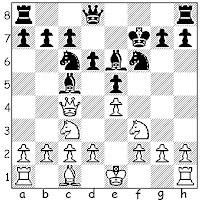As a therapist in my "day job" I often have the opportunity to help my clients expand their understanding of consequences of behaviors by asking them to look further: "And then what...?"
In the following game Black does a good job of defusing the primar threat behind White's 6th move, but he then becomes lax at just about the time he should have asked himself "And then what...?"
Wall,B - Guest1459913
Playchess.com, 2013
1.e4 e5 2.Nf3 Nc6 3.Bc4 Nf6 4.Nc3 Bc5 5.Bxf7+
5...Kxf7 6.Qe2
A quiet move that you can find in a number of Bill's Jerome Gambit games.
6...d6
Dodging the misfortunes of 6...h6 7.Qc4+ in Wall,B - DarkKnight, Cocoa Beach, FL 2012 (1-0, 23); 6...Rf8 7.Qc4+ in Wall,B - Roberts,C, Chess.com, 2010 (1-0, 17), Wall,B - Hamilton,E, FICS, 2011 (1-0, 22) and Wall,B - NFNZ, FICS, 2011 (1-0, 15).
An alternate was 6...d5 as in the rare Wall,B - Samvazpr, Chess.com, 2010 (0-1, 25)
7.Qc4+ Be6?
You can almost read Black's mind: I took care of that move with 6...d6. Now I strike back by attacking the Queen with my Bishop!
8.Ng5+
Oh, well, yes, there is that...
8...Kg6 9.Nxe6 Qd7
10.f4
Threatening 11.f5+ Kf7 12.Nxc5+, winning the Queen.
10...h6 11.fxe5 Nxe5 12.Nxc5 Nxc4 13.Nxd7 Nxd7 14.d3 Nce5 15.0-0 c6
Players like myself (and perhaps Guest1459913) are often relieved, if not downright hopeful, when we find ourselves facing a strong player like Bill, being "only" a pawn down - with Queens off of the board, to boot.
This is usually an error in thinking: strong players can wield that extra pawn the way ordinary players wield an extra piece.
16.h4 Rhf8 17.Bd2 Kh5 18.Ne2 Kxh4 19.Nd4 g5 20.Nf5+ Kh5 21.Nxd6 b6
In case anyone is paying attention, White now has a protected passed pawn.
22.d4 Ng4 23.Nf5 Kg6? 24.Ne7+ Kh5
25.Nxc6
This wins another pawn, although Bill points out that 25.Rf3! was stronger.
25...Ndf6 26.Bb4 Rfc8 27.Ne7 Rxc2? 28.Rf3
Threatening 29.Rh3 mate
28...Ne3 29.Rxe3 Rxb2 30.Rh3+ Kg4 31.Rf1 Nxe4 32.Nd5 Re2 33.Ne3+ Rxe3 34.Rxe3 Ng3 35.Rff3 Nh5 36.Bd6 Rd8 37.Re4+ Nf4 38.Bxf4 Black resigned
















